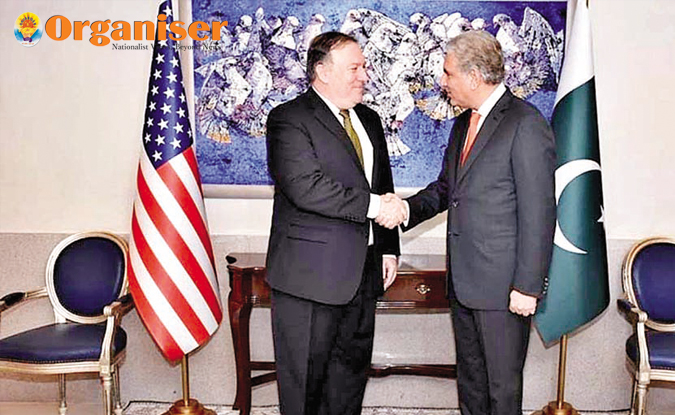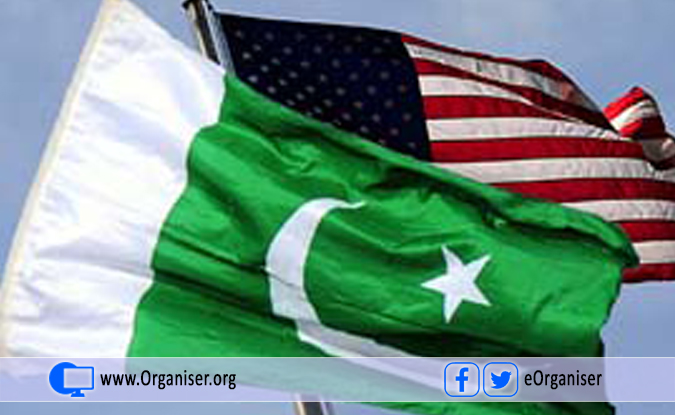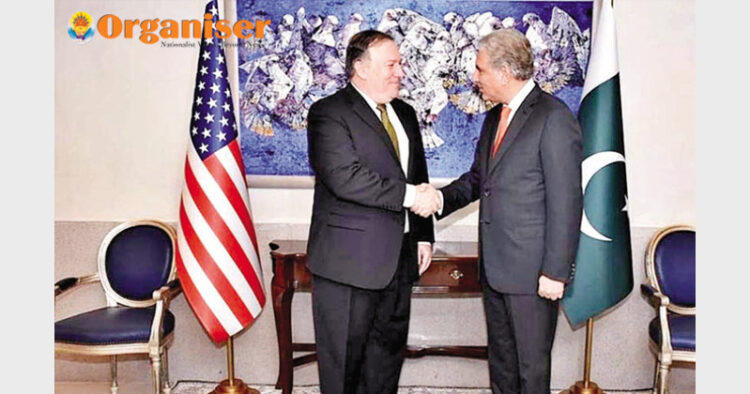Pakistan’s economic situation is getting worse and urgently needs funds, but the United States emerges as a significant obstacle in achieving the requisite funds from the International Monetary Fund
Santosh K Verma
The visit of the US Secretary of State to Pakistan is considered as an important event, and it is believed that after the formation of a new government under the leadership of Imran Khan in the country, reforms in relations with the US can begin. But just a few days before the visit of Secretary of State Mike Pompeo, the US Department of Defence has announced a reduction of the permanent assistance of 300 million dollars to Pakistan.

US secretary of state Mike Pompeo (left) with Pakistan Foreign Minister Shah Mehmood Qureshi in Islamabad
Earlier, at the beginning of August 2018, the US had published a plan to reduce the aid given to Pakistan by 75 per cent and brought it from the US $ 1 billion to $ 150 million.
The Trump administration says Islamabad has provided shelter to the Taliban fighters during the 17-year war in Afghanistan. On this cut, Pentagon spokesman Lieutenant Konne Falconer noted that after approval by Congress this money would be allocated for other “immediate priorities”.
Some analysts of international relations also believe that this is a possible American reaction against Pakistan’s move to be the first to welcome Iran’s foreign minister, Javed Zarif, in Pakistan as a “diplomatic guest” and assure support of Iran on the nuclear deal. Last week, Pakistan’s Foreign Minister Shah Mahmood Qureshi had made a statement alleging the US was lying. He alleges that it’s not true that Mike Pompeo had pressurised the Prime Minister to make “decisive action” against the terrorists.

It is noteworthy that the assistance offered by this so-called Coalition Support Fund was suspended earlier this year (Pakistan had failed to take action against militant groups such as the Afghan Taliban and the Haqqani Network, and for growing proximity to China). US had stopped the aid of US $ 1.5 billion to Pakistan when US President Donald Trump said in a tweet that since 2002, US has found nothing else but “lies and deception” for funding of 33 billion dollars to Pakistan. Under the regime of previous President Barack Obama, Enhanced Partnership with Pakistan Act of 2009, which is also known as the Keri-Luger-Burman Act, was provided assistance of US $ 1.2 billion per year to Pakistan.
American Aid to Pakistan
American aid to Pakistan began in 1947. America was among the first countries to recognise Pakistan. The US had provided both military and civilian assistance to Pakistan. American aid laid the foundation stone of many civil institutions in Pakistan such as Institute for Business Administration, Jinnah Post Graduate Medical Center, Sindhu Basin Project, Faisalabad Agriculture Institute (which was going to pave the way for the Green Revolution of Pakistan).
In the 1960s and 1970s, the United States was a significant donor for the construction of Mangla and Tarbela dams, which provided 70 per cent of Pakistan’s total power generation after completion. In the early 1980s and early 1990s, the United States helped build Guddu Power Station in Sindh, and Lahore University for Management Sciences which is now considered one of the top business schools in the country.
1.A significant portion of US aid to be given since 2002 is given under the Foreign Military Financing Programme, which was approximately $ 3.8 billion, besides a $ 2.35 billion funding under the Pakistan Counter-Insurgency Fund and Counter Insurgency Capability Fund
2. According to a US think tank, Pakistan received $ 67 billion in aid during 1951-2011, which became the mainstay of Pakistan’s economy
2. According to a US think tank, Pakistan received $ 67 billion in aid during 1951-2011, which became the mainstay of Pakistan’s economy
At the same time, Pakistan was receiving a large number of military assistance from the US to become an active member of SEATO and CENTO until 1955. The Security Agreement of 1954 prompted the United States to provide Pakistan as financial aid between 1954 and 1964 to approximately $ 2.5 billion and 700 million in military funding. In 1962, American aid to Pakistan reached its highest level of 2 billion dollars.
Immediately after the Indo-Pakistani wars of 1965 and 1971, US military aid declined, and after the CIA’s confirmation in 1979 that Pakistan is annexed to the creation of nuclear bombs, then-President Jimmy Carter suspended all assistance (excluding food aid) to Pakistan. But the entry of the Soviet Union in Afghanistan and the mujahideen war against it completely reversed the conditions. Now Pakistan became the most trusted partner of the United States in the fight against the Soviet Union, and it provided plenty of military and civilian assistance. During this decade, Pakistan received the US $ 5 billion in aid.
But the beginning of the 1990s shows a mark of change. The Soviet Union had returned from Afghanistan, and its disintegration had diminished the chances of spreading its territory in the future. In such a situation, it was necessary for America to see Pakistan’s “bad deeds”. In 1993, United States Agency for International Development (US AID’s) Pakistan mission was also closed. In this decade, US aid came in at least $ 429 million in military assistance and $ 5.2 million as military aid, and the Pakistanis began to bitterly say that the United States used them for decades as a tissue paper.
In 1998, after the Nawaz Sharif Government’s nuclear tests and global demonstration of nuclear power, more large reductions were made in aid. After Parvez Musharraf’s return to power, the pressure on Pakistan was increasing, and the necessary condition of the help was re-establishment of democracy. But after the 9/11 terrorist incident in America, Goddess of Destiny once again turned to Pakistan.
The then US President George Bush Jr. announced the global war against terrorism, whose first and the foremost target was Afghan Taliban rule. This was the same Taliban that the United States had to propagate against the Soviet Union during the Mujahedeen War with the help of Pakistan. At the same time, Osama bin Laden, who had become the face of global terrorism as the founder of Al-Qaeda, was on the target of America and it was believed that he had taken shelter in Afghanistan, and the cost of proximity to Afghanistan’s oldest mujahedeen had to be paid.
At the same time, the US offered Pakistan’s military leadership to join hands against terrorism, which Pakistan took promptly against the will of a vast majority who sympathised with the Taliban. And once again, the decade of 1980 came back, Pakistan has floated in civilian assistance in large quantities.
Between 2001 and 2009, the US once again strengthened its financing commitments, and in support of military assistance by Pakistan for its operations, reimbursement and the army assistance in Afghanistan, along with its rough border areas, of about $ 9 billion Provided and an extra fund of $ 3.6 billion for economic and diplomatic initiatives. Between 2002 and 2009, 70 per cent of total American assistance was spent for security-related matters, which directly impacted terrorism of its neighbouring countries like India.
As it happened in the 1980s and 90s, a new, $ 7.5 billion aid package was passed for five years by the Congress in September 2009 by the Keri-Luger-Burman Act (KLB), also known as Enhanced Partnership with Pakistan Act of 2009 and was signed by President Obama in October 2009. However, in which the money was prohibited to use for nuclear proliferation, supporting terrorist groups, or to pay for the attacks in neighbouring countries.
Since 2002, the US has given Pakistan $ 14.573 billion under CSF. CSF payment was 43.65 per cent of total American payments to Pakistan during the last 15 years. A significant portion of US aid to be given since 2002 is given under the Foreign Military Financing Programme, which was approximately $ 3.8 billion, besides a $ 2.35 billion funding under the Pakistan Counter-Insurgency Fund and Counter Insurgency Capability Fund. The third significant share was $ 911 million, which was given under the US International Narcotics Control and Law Enforcement Program.
By comparison, from 2014, US aid has grown to $ 1.6 billion per year, between 2002 and 2013, an average of $ 2.3 billion per year. This includes reimbursement of Coalition Assistance Fund (CSF). There has been a reduction in the time since Barack Obama’s Presidential tenure, but after the arrival of Trump, it is facing a severe jolt. Pakistan’s growing proximity to China is also one of the main reasons. According to a US think tank, Pakistan received $ 67 billion in aid during 1951-2011, which became the mainstay of Pakistan’s economy.
At present, Pakistan’s economic situation is getting worse and urgently needs funds, but the US emerges as a significant obstacle in achieving the necessary funds from the International Monetary Fund. Imran Khan’s attitude towards America has not been like a skilled politician. In such a way, how China’s co-operation removes Pakistan’s
economic crisis! (the primary cause of the crisis is also China). Pakistan and its leaders should now understand that the period of “Charlie Wilson” is over and dreams of Pakistan’s prosperity and power will be nightmares because of edacity of easy money.
(The writer is a researcher and regularly observes Pakistan media)














Comments